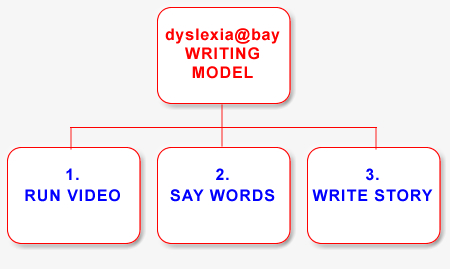Writing Difficulties
When student are asked to write a story, for example, “My Summer Holiday”, they use the model above. Firstly, they go back to the beginning of the holiday and run a video about preparing for the holiday, arriving at the destination, and then can run a video about each day and what happened and then finish off with their return home. As they run the video they can pause it at any stage and write down the description of it in words. Using this technique, students will not lose the point of the story they are writing and the story will be written in a logical format. Those students who are excellent at story writing, can portray their thoughts with wonderful expression and excellent use of vocabulary.

Stage 1
There are many students with dyslexia who are unable to access their Visual Dynamic Memory. Therefore when they are asked to write a story they are unable to run ”videos” in their heads, but use a series of still pictures to process their story. This results in lack of sequence or losing the point of the story being written.
(For a more detailed explanation of this process, see Chapter 7 of the book Dyslexia An Explanation.
Stage 2
Even if one is able to create the story effectively, the actual expression of these thoughts into words is an integral part of writing. To do this effectively students must have a strong link between the Visual Dynamic Memory and the auditory memory or internal dialogue. Students with poor connections are often accused of having limited vocabulary.
Stage 3
This final part of writing is very much connected to stage 4 in the d@b model of spellings. Regardless of how creative the story is or how rich the vocabulary is, if a student is unable to write down the corresponding words correctly s/he may be accused of being careless and not bothering. Students can often resort to techniques such as relying heavily on common words that they definitely know how to spell rather than attempt to write the word that best describes their thoughts. Other students, with dyslexia are great at telling stories orally with plenty of description and feeling, but yet this is not transferred to their written work. For a more detailed explanation see Chapter 7 of the book Dyslexia An Explanation.
